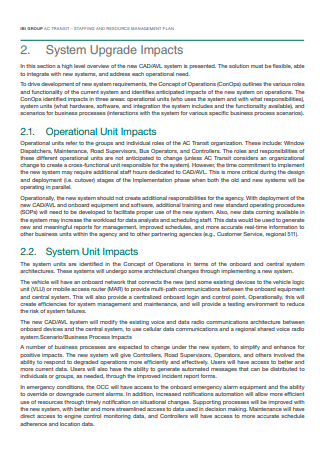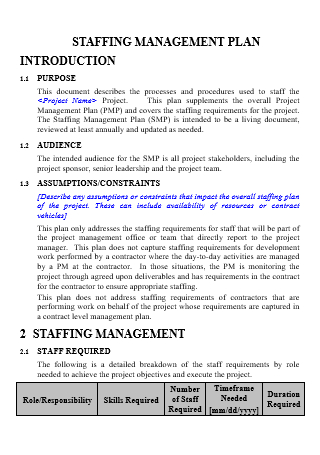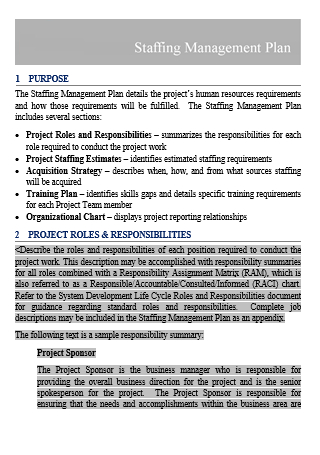5+ Sample Staffing Management Plan
FREE Staffing Management Plan s to Download
5+ Sample Staffing Management Plan
What Is a Staffing Management Plan?
Components of a Staffing Management Plan
Significance of Staffing Management in Organizations
How To Write Staffing Management Plan
FAQs
What are examples of staffing in the workplace?
What is the initial step in writing a staffing plan?
How do you implement project staffing?
What Is a Staffing Management Plan?
A staffing management plan is a business document that aims to aid organizations in identifying and acquiring staff members and employees at all levels and all departments of an organization. A well-developed staffing management plan addresses the needs of an organization in various ways. It depends on the structure, business model, project completion processes, and staffing deadlines. A staffing management plan defines the overall approach of a company for its staffing projects to accommodate problems or issues about acquisition timelines for employee contractors and outsourcing agencies. It also defines the work schedule of staffing employees and the time of termination of their employment. The plan also describes the training requirements, project location, team-building techniques and strategies, and all other components that contribute to the success of a program or project, achieving the goal statement the company sets. Do not confuse a staffing management plan with a human resource management plan, despite the similarities between the two.
According to the data from Statista regarding the distribution of staffing and recruiting industry sales in the United States from 2015 to 2019, about 85 percent of employees are temporary and contract workers, while 15 percent consists of search and placement employees through detailed staffing plans.
Components of a Staffing Management Plan
Staffing management plans aim to address the needs of an organization at present and in the future. As such, it gives the company sufficient time to find solutions in terms of staffing problems and issues to guarantee that projects or programs become achievable. If the organization leaves everything at the last minute, there will be grave consequences in the end. For the company to accomplish daily tasks, resume daily operations, deal with unpredictable emergencies, and avoid any more delays on projects, having a staffing management plan is a priority. The section below details the essential elements that the document needs, including descriptions to help better understand them.
Significance of Staffing Management in Organizations
Many businesses become unsuccessful due to financial distress from poor human resource management. Since employees are one of the most valuable assets that a company has, they must protect their workforce as much as possible. Human resources must undergo continual and constant monitoring with proper adjustments and assessments as necessary, similar to other company assets. The section below talks about the significance of staffing management in organizations.
How To Write Staffing Management Plan
First and foremost, a staffing management plan must be comprehensive. The staffing management plan shares its similarities with the recruitment process. As such, the document must contain similar elements, incorporating contingencies and provisions essential to the hiring process. The section below details the different steps to help you create a staffing management plan for your company.
-
1. Identify the Staffing Necessities of the Company
This is the first and most vital step in the staffing management plan. It is necessary to identify what the organization needs in terms of human resources. The things to consider for the staffing needs of a company range from departmental business goals, technical and soft skills of candidates, and type of work or workers. It is also necessary that everyone working on the staffing management plan are in agreement with the needs of the company.
-
2. Establish Schedules and Budgeting Plans
The staffing management plan must contain a hiring and employment timeline. The hiring timeline refers to a particular date wherein candidates are hired. Without a clear timeline, there are no deadlines for hiring new employees. Meaning there is a possibility of missing hiring deadlines that can cause delays in meetings and project completion. Employment timeline refers to an employee’s employment term. Full-time employees work until they want to or until the company wants to hire them for the position. For contract employees or contingent employees, there is a set date. When it comes to budgeting plans, direct hire and contract workers have separate budgets. The company must establish, clarify, and approve hiring budgets before hired workers start with their jobs.
-
3. Construct and Implement Talent Acquisition Strategies
There are different ways that the company can proceed with hiring employees since there are different types of talent that an organization requires. Active job seekers are individuals who are actively looking for job opportunities. These people are either currently unemployed or employed but are seeking opportunities elsewhere. Passive candidates are those who are not actively seeking but are open to exploring better possibilities from their current employment. Different types of candidates need different acquisition strategies.
-
4. Develop and Execute an Onboarding Program
The onboarding process allows the company to become familiar with daily operations and to express to the new hire that they made the right choice to join the company. Onboarding begins as soon as the candidate accepts the job offer. The process starts early on to make the employee feel comfortable and welcome. If the onboarding procedure starts much later, between the offer and the start of work, it is more likely that the candidate will show disinterest with the risk of fall-off.
-
5. Discern the Proper Training Materials and Programs for Employees
The training process does not end in the onboarding process but the entire training program for new employees. Training is continuous, especially if it helps an employee to become more productive and provide additional value to the organization. Training not only helps employee productivity but also helps the company by bringing effective services and quality products. Identify all the necessary materials and programs that employees need to satisfy hiring needs to fulfill company objectives.
FAQs
What are examples of staffing in the workplace?
Some examples of staffing include temporary hires, direct-hire, seasonal employees, bilingual employees, among others.
What is the initial step in writing a staffing plan?
The first step to any staffing plan is to evaluate the needs according to the goal that an organization wishes to achieve.
How do you implement project staffing?
Project staffing is a method that companies use to form a project team that fulfills certain roles and functions and assigned tasks.
Staffing management is advantageous to companies that seek growth and development by hiring competent and well-experienced employees to join their roster. Whether these employees are new to the industry, the staffing management plan provides a comprehensive guideline to acquiring human resources for programs and projects for the company. No matter the size of the company, instituting the document provide solutions for skill gaps, lessen employee turnovers, and increase brand reputation. Start developing a staffing management plan for your organization by downloading the 5+ SAMPLE Staffing Management Plan in PDF | MS Word available in the article. Get yours today, only at Sample.net.






